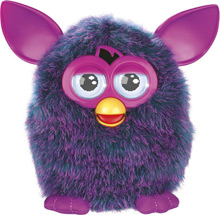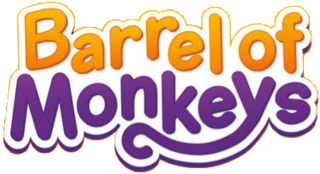
Hasbro, Inc. is an American multinational conglomerate holding company incorporated and headquartered in Pawtucket, Rhode Island. Hasbro owns the trademarks and products of Kenner, Milton Bradley, Parker Brothers, and Wizards of the Coast, among others. As of August 2020, over 81.5% of its shares were held by large financial institutions.

Twister is a game of physical skill produced by Milton Bradley Company and Winning Moves Games USA. It is played on a large plastic mat that is spread on the floor or ground. The mat has four rows of six large colored circles on it with a different color in each row: red, yellow, green and blue. A spinner tells players where they have to place their hand or foot. The game promotes itself as "the game that ties you up in knots".
An action figure is a poseable character model figure made most commonly of plastic, and often based upon characters from a film, comic book, military, video game or television program; fictional or historical. These figures are usually marketed toward boys and adult collectors. The term was coined by Hasbro in 1964 to market G.I. Joe to boys.

Jenga is a game of physical skill created by British board game designer and author Leslie Scott and marketed by Hasbro. Players take turns removing one block at a time from a tower constructed of 54 blocks. Each block removed is then placed on top of the tower, creating a progressively more unstable structure.

Furby is an American electronic robotic toy that was originally released in 1998 by Tiger Electronics. It resembles a hamster or owllike creature and went through a period of being a "must-have" toy following its holiday season launch, with continual sales until 2000. Over 40 million Furbies were sold during the three years of its original production, with 1.8 million sold in 1998, and 14 million in 1999. Its speaking capabilities were translated into 14 languages.

Candy Land is a simple racing board game created by Eleanor Abbott and published by Milton Bradley in 1948. The game requires no reading and minimal counting skills, making it suitable for young children. No strategy is involved as players are never required to make choices; only following directions is required. About one million copies per year are sold.

Mr. Potato Head is an American toy brand consisting of a plastic model of a potato "head" to which a variety of plastic parts can attach — typically ears, eyes, shoes, hat, nose, pants and mouth.

Simon is an electronic game of short-term memory skill invented by Ralph H. Baer and Howard J. Morrison, working for toy design firm Marvin Glass and Associates, with software programming by Lenny Cope. The device creates a series of tones and lights and requires a user to repeat the sequence. If the user succeeds, the series becomes progressively longer and more complex. Once the user fails or the time limit runs out, the game is over. The original version was manufactured and distributed by Milton Bradley and later by Hasbro after it took over Milton Bradley. Much of the assembly language code was written by Charles Kapps, who taught computer science at Temple University and also wrote one of the first books on the theory of computer programming. Simon was launched in 1978 at Studio 54 in New York City and was an immediate success, becoming a pop culture symbol of the 1970s and 1980s.

Don't Break the Ice is a children's tabletop game for two to four players ages 3 and up. First marketed by Schaper Toys in 1968, the game was sold to Hasbro subsidiary Milton Bradley in 1986. It is still in production, and special editions were released in conjunction with the films Frozen (2013) and Frozen II (2019).

Nerf is a toy brand formed by Parker Brothers and currently owned by Hasbro. Most of the toys are a variety of foam-based weaponry, with other Nerf products including balls for sports such as American football, basketball, and baseball. Their best known toys are their dart guns that shoot ammunition made from "Nerf foam". Their primary slogan, introduced in the 1990s, is "It's Nerf or Nothin'!". Annual revenues under the Nerf brand are approximately US$400 million.

B-Daman is a marble shooting toy franchise produced in Japan by Takara. It was originally based on the Bomberman series, but later expanded into other franchises and its own original designs.
GoBots is a line of transforming robot toys produced by Tonka from 1983 to 1987, similar to Hasbro's Transformers.

Lite-Brite is a toy that was originally marketed in 1967. It consists of a light box with small colored plastic pegs that fit into a panel and illuminate to create a lit picture, by either using one of the included templates or creating a "freeform" image on a blank sheet of black paper.

Barrel of Monkeys is a toy game released by Lakeside Toys in 1965. It was created by Leonard Marks and Milton Dinhofer in 1961, and in 1964, Herman Kesler partnered to sell it to Lakeside Toys, which released it in 1965. It was then produced by the Milton Bradley Company, and Hasbro. Milton Bradley's editions consisted of a toy barrel in either blue, yellow, red, purple, orange, gray or green. The barrel contains 13 monkeys but can hold 24, their color usually corresponding to the barrel's color. The instructions state, "Dump monkeys onto table. Pick up one monkey by an arm. Hook other arm through a second monkey's arm. Continue making a chain. Your turn is over when a monkey is dropped." In addition to these basic instructions, the barrel also contains instructions for playing alone or with two or more players.

Marvin Glass and Associates (MGA) was a toy design and engineering firm based in Chicago. Marvin Glass (1914–1974) and his employees created some of the most successful toys and games of the twentieth century such as Mr. Machine, Rock 'Em Sock 'Em Robots, Lite Brite, Ants in the Pants, Mouse Trap, Operation, Simon, Body Language, and the Evel Knievel Stunt Cycle.
The Hasbro G.I. Joe Hall of Fame era of 12" action figures began in 1991, when Hasbro released the Target Exclusive Duke in response to the high demand from nostalgic collectors of the vintage era G.I. Joe action figures. Duke was the first 12" (30 cm) action figure produced in the Hasbro G.I. Joe line since 1978. During the G.I. Joe Hall of Fame era, Hasbro introduced several new products to the world of action figure collectibles. The first innovation was the limited edition, individually numbered collectible figures. These figures had collectors scrambling to find the lowest numbers which were expected to have the highest resale value. Hasbro also used variant sets to increase demand and interest in the figures. Additionally, talking voice chips were used in some figures; and limited edition action figure sets were released for the Street Fighter II video game and movie characters, and also for the Mortal Kombat characters.

G.I. Joe: America's Movable Fighting Man is a line of action figures produced by Hasbro. The initial product offering represented four of the branches of the U.S. armed forces. The term G.I. stands, in popular usage, for Government Issue and became a generic term for U.S. soldiers, especially ground forces. The term originated in WWI, when much of the government-issued equipment was stamped "G.I.", meaning that it was made from galvanized iron. The development of G.I. Joe led to the coining of the term "action figure".

Schaper Toys, or W.H. Schaper Mfg. Co., Inc. as it was originally known, was a game and toy company founded in 1949 by William Herbert Schaper in Robbinsdale, Minnesota. "Herb" Schaper published a variety of games but was best known for having created the children's game, Cootie. In 1971, the company was sold to Kusan, Inc., and began operating as Schaper Toys, a subsidiary of Kusan, Inc. In 1986, Schaper Toys was acquired by Tyco Toys, which sold the rights to Cootie and three other of the company's best-known games to the Milton Bradley Company. These games are still being sold.
Don't Spill the Beans is a children's game for 2 or more players ages 3–6 published by Milton Bradley Company, a subsidiary of Hasbro, Inc. The game was originally manufactured by Schaper Toys but acquired by Milton Bradley in 1986 through its then owner, Tyco Toys. The game is described by Hasbro as a "Classic Preschool Game. A Favorite For More Than 30 Years!".

A Nerf Blaster is a toy gun made by Hasbro that fires foam darts, arrows, discs, or foam balls. “Nerf blaster” or more commonly “Nerf gun” are often used to describe the toy. Nerf blasters are manufactured in multiple forms; the first Nerf blasters emerged in the late 1980s with the release of the Nerf Blast-a-Ball (1989) and the Sharpshooter (1992). Today, Hasbro has produced over twenty unique lines of Nerf-brand blasters, with each line centered on a particular theme or type of ammunition. Hasbro has also produced Nerf blasters based on specific franchises, including Marvel Comics, Star Wars, G.I. Joe, Fortnite, Transformers, Overwatch, Halo Infinite, and Roblox. Nerf blasters are available in several international marketplaces, although some blasters have their names changed or are not sold in certain countries due to laws surrounding toy safety franchises.














